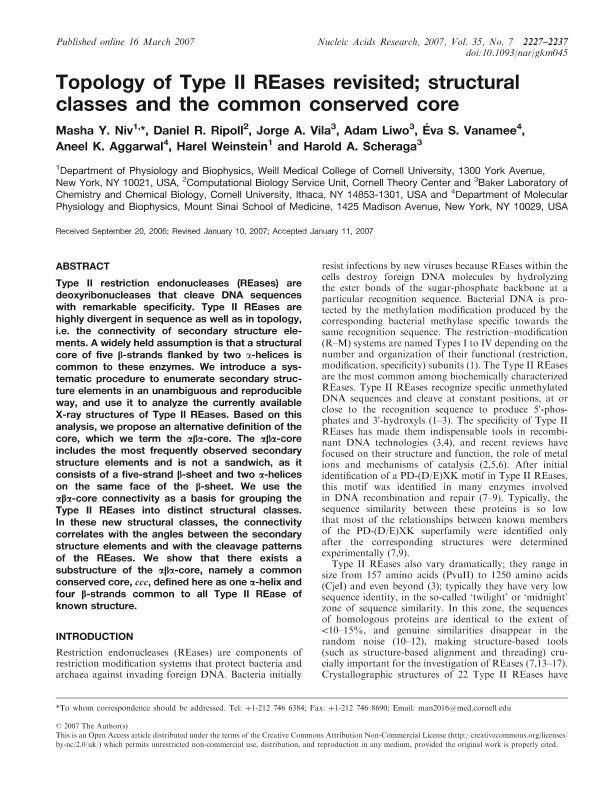Mostrar el registro sencillo del ítem
dc.contributor.author
Niv, Masha Y.
dc.contributor.author
Ripoll, Daniel R.
dc.contributor.author
Vila, Jorge Alberto

dc.contributor.author
Liwo, Adam
dc.contributor.author
Vanamee, Éva S.
dc.contributor.author
Aggarwal, Aneel K.
dc.contributor.author
Weinstein, Harel
dc.contributor.author
Scheraga, Harold A.

dc.date.available
2020-12-02T20:38:44Z
dc.date.issued
2007-04
dc.identifier.citation
Niv, Masha Y.; Ripoll, Daniel R.; Vila, Jorge Alberto; Liwo, Adam; Vanamee, Éva S.; et al.; Topology of Type II REases revisited; structural classes and the common conserved core; Oxford University Press; Nucleic Acids Research; 35; 7; 4-2007; 2227-2237
dc.identifier.issn
0305-1048
dc.identifier.uri
http://hdl.handle.net/11336/119675
dc.description.abstract
Type II restriction endonucleases (REases) are deoxyribonucleases that cleave DNA sequences with remarkable specificity. Type II REases are highly divergent in sequence as well as in topology, i.e. the connectivity of secondary structure elements. A widely held assumption is that a structural core of five β-strands flanked by two α-helices is common to these enzymes. We introduce a systematic procedure to enumerate secondary structure elements in an unambiguous and reproducible way, and use it to analyze the currently available X-ray structures of Type II REases. Based on this analysis, we propose an alternative definition of the core, which we term the αβα-core. The αβα-core includes the most frequently observed secondary structure elements and is not a sandwich, as it consists of a five-strand β-sheet and two α-helices on the same face of the β-sheet. We use the αβα-core connectivity as a basis for grouping the Type II REases into distinct structural classes. In these new structural classes, the connectivity correlates with the angles between the secondary structure elements and with the cleavage patterns of the REases. We show that there exists a substructure of the αβα-core, namely a common conserved core, ccc, defined here as one α-helix and four β-strands common to all Type II REase of known structure.
dc.format
application/pdf
dc.language.iso
eng
dc.publisher
Oxford University Press

dc.rights
info:eu-repo/semantics/openAccess
dc.rights.uri
https://creativecommons.org/licenses/by-nc-sa/2.5/ar/
dc.subject
REASES
dc.subject
CLEAVE DNA
dc.subject.classification
Física Atómica, Molecular y Química

dc.subject.classification
Ciencias Físicas

dc.subject.classification
CIENCIAS NATURALES Y EXACTAS

dc.title
Topology of Type II REases revisited; structural classes and the common conserved core
dc.type
info:eu-repo/semantics/article
dc.type
info:ar-repo/semantics/artículo
dc.type
info:eu-repo/semantics/publishedVersion
dc.date.updated
2020-09-24T14:26:51Z
dc.identifier.eissn
1362-4962
dc.journal.volume
35
dc.journal.number
7
dc.journal.pagination
2227-2237
dc.journal.pais
Reino Unido

dc.journal.ciudad
Oxford
dc.description.fil
Fil: Niv, Masha Y.. Cornell University; Estados Unidos
dc.description.fil
Fil: Ripoll, Daniel R.. Cornell Theory Center; Estados Unidos
dc.description.fil
Fil: Vila, Jorge Alberto. Consejo Nacional de Investigaciones Científicas y Técnicas. Centro Científico Tecnológico Conicet - San Luis. Instituto de Matemática Aplicada de San Luis "Prof. Ezio Marchi". Universidad Nacional de San Luis. Facultad de Ciencias Físico, Matemáticas y Naturales. Instituto de Matemática Aplicada de San Luis "Prof. Ezio Marchi"; Argentina
dc.description.fil
Fil: Liwo, Adam. Cornell University; Estados Unidos
dc.description.fil
Fil: Vanamee, Éva S.. Mount Sinai School of Medicine; Estados Unidos
dc.description.fil
Fil: Aggarwal, Aneel K.. Mount Sinai School of Medicine; Estados Unidos
dc.description.fil
Fil: Weinstein, Harel. Cornell University; Estados Unidos
dc.description.fil
Fil: Scheraga, Harold A.. Cornell University; Estados Unidos
dc.journal.title
Nucleic Acids Research

dc.relation.alternativeid
info:eu-repo/semantics/altIdentifier/doi/http://dx.doi.org/10.1093/nar/gkm045
dc.relation.alternativeid
info:eu-repo/semantics/altIdentifier/url/https://academic.oup.com/nar/article/35/7/2227/1086673
Archivos asociados
